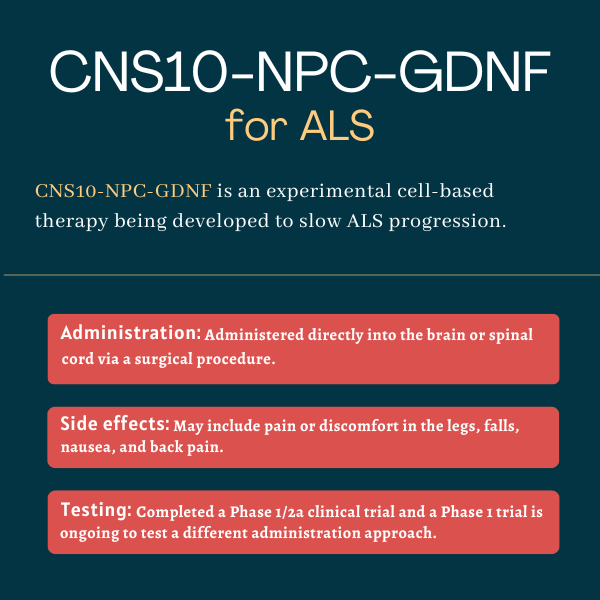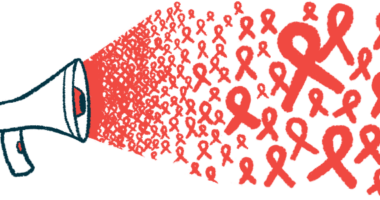CNS10-NPC-GDNF for ALS
Last updated July 29, 2024, by Marisa Wexler, MS

What is CNS10-NPC-GDNF for ALS?
CNS10-NPC-GDNF is an experimental stem cell-based therapy being developed to potentially slow disease progression and extend survival in people with amyotrophic lateral sclerosis (ALS).
It is being developed by researchers at Cedars-Sinai Medical Center in Los Angeles to be surgically administered into specific regions of the spinal cord or brain.
Therapy snapshot
| Treatment name: | CNS10-NPC-GDNF |
| Administration: | Surgically administered into the spinal cord or brain |
| Clinical testing: | Phase 1/2a trial completed; currently in a Phase 1 trial |
How does CNS10-NPC-GDNF work?
ALS is caused by the death of motor neurons, which are nerve cells that control the movement of voluntary muscles. The disease also affects other cells in the nervous system, including astrocytes, which are star-shaped cells that help support nerve function.
Astrocytes can support the health and integrity of motor neurons in part by secreting a specific protein called glial-derived neurotrophic factor (GDNF), which is crucial for the survival of motor neurons. In ALS, astrocytes degenerate as the disease progresses.
CNS10-NPC-GDNF is a stem cell-based therapy containing human neural progenitor cells that have been genetically engineered to produce GDNF. The therapy specifically uses stem cells derived from human fetal tissue, which are able to differentiate into mature astrocytes, given the right cues.
When transplanted into the brain or spinal cord of ALS patients, it is hoped that the cells will grow into astrocytes and provide GDNF to motor neurons. This is expected to increase the survival of motor neurons, thereby slowing motor function decline and delaying disease progression.
How will CNS10-NPC-GDNF be administered in ALS?
In early clinical trials, CNS10-NPC-GDNF was administered directly into the nervous system via a surgical procedure.
In one trial, the cell therapy was transplanted to 10 sites in the lumbar region of the spinal cord using a stereotactic frame that was specifically designed for this therapy. The device helps ensure the transplanted cells are injected in precise spots within the spinal cord.
Another trial is testing CNS10-NPC-GDNF delivered by injection to sites in the motor cortex, which is a region in the brain that plays a central role in coordinating movement. The therapy will be injected into 21 different sites within the motor cortex, at total doses ranging from 5.26 million to 10.5 million cells.
CNS10-NPC-GDNF in clinical trials
CNS10-NPC-GDNF has been tested in a now completed Phase 1/2a clinical trial (NCT02943850) where cells were administered into the lower spinal cord, and an ongoing Phase 1 study (NCT05306457) is testing CNS10-NPC-GDNF delivered into the brain’s motor cortex.
Both trials included adults, 18 and older, who experienced their first symptoms up to three years before enrollment. They were all given the therapy unilaterally, that is, only to one side of the body.
Spinal cord Phase 1/2a study
This study enrolled 18 people with ALS who had evidence of disease involvement in the lower spinal cord. All of the participants were treated with CNS10-NPC-GDNF delivered at 10 sites along one side of the lower spine, which is where motor neurons that control the legs reside.
The first nine participants were given a dose of 200,000 cells per site (a total of 2 million cells), and the next nine participants got 500,000 cells per site for a total of 5 million cells. As CNS10-NPC-GDNF uses cells that aren’t from the patients themselves, participants were given immune-suppressing medications to prevent the body from rejecting the transplanted cells.
The study’s main goal was to evaluate the safety of CNS10-NPC-GDNF, and results were positive with no reported serious safety issues associated with the therapy.
Most participants reported pain, tingling, or other unusual sensations in the thigh, where muscles are innervated by nerves close to the injection site. In some patients, these unusual sensations resolved quickly, though half of the patients reported sensations lasting six months or more following surgery.
While this early study was not designed to test the efficacy of CNS10-NPC-GDNF, researchers conducted exploratory analyses to directly compare leg strength on the side that was treated versus the side that was not.
Data indicated the decline in strength tended to be slower on the treated side than on the untreated side, though none of the differences reached statistical significance.
Analyses of spinal cord and brain tissue from study participants who died due to ALS progression indicated the transplanted cells were able to survive and produce GDNF as designed.
Brain Phase 1 study
A separate Phase 1 study is ongoing to test CNS10-NPC-GDNF delivered into the motor cortex. That trial seeks to enroll about 16 patients who have progressive weakness in their arms.
Participants in this study will be sequentially assigned to one of three groups, all of which will receive injections of the cell therapy along 21 sites on one side of the motor cortex.
The first group will be given 250,000 cells per site (5.25 million cells in total) on the side of the motor cortex that corresponds to the patient’s non-dominant hand. The second and third groups will receive 500,000 cells per site (10.25 million cells in total) on the side corresponding to the non-dominant and dominant hand, respectively.
The main goal of this trial is to assess the safety of CNS10-NPC-GDNF over one year. Researchers will also explore how the treatment affects measures of arm strength and hand function, as well as changes in MRI activity in the motor cortex, and measures of how muscles respond to nerve signals.

Common side effects of CNS10-NPC-GDNF
In a clinical trial in which CNS10-NPC-GDNF was injected into the lower spinal cord, most patients experienced pain, discomfort, tingling, or other unusual sensations in the thigh, which is where nerves from the lower spine connect.
Other common side effects reported during the trial included falls, pain in the extremities, nausea, back pain, and muscular weakness, though these are all commonly associated with ALS, immune-suppressing treatments, and surgery. No serious side effects were deemed related to treatment.
The therapy’s safety profile when administered to the brain is currently under investigation.
ALS News Today is strictly a news and information website about the disease. It does not provide medical advice, diagnosis, or treatment. This content is not intended to be a substitute for professional medical advice, diagnosis, or treatment. Always seek the advice of your physician or other qualified health provider with any questions you may have regarding a medical condition. Never disregard professional medical advice or delay in seeking it because of something you have read on this website.
Related articles






